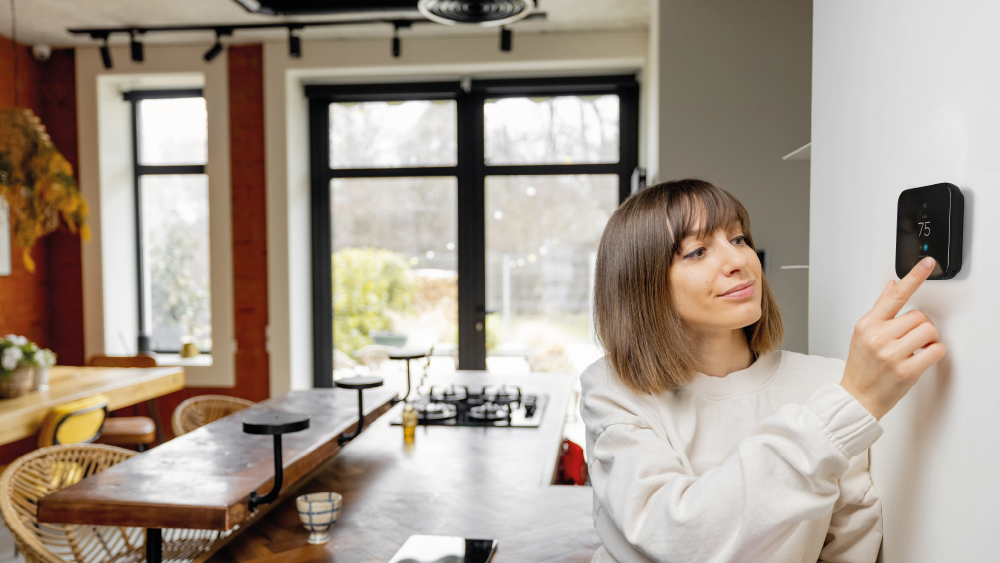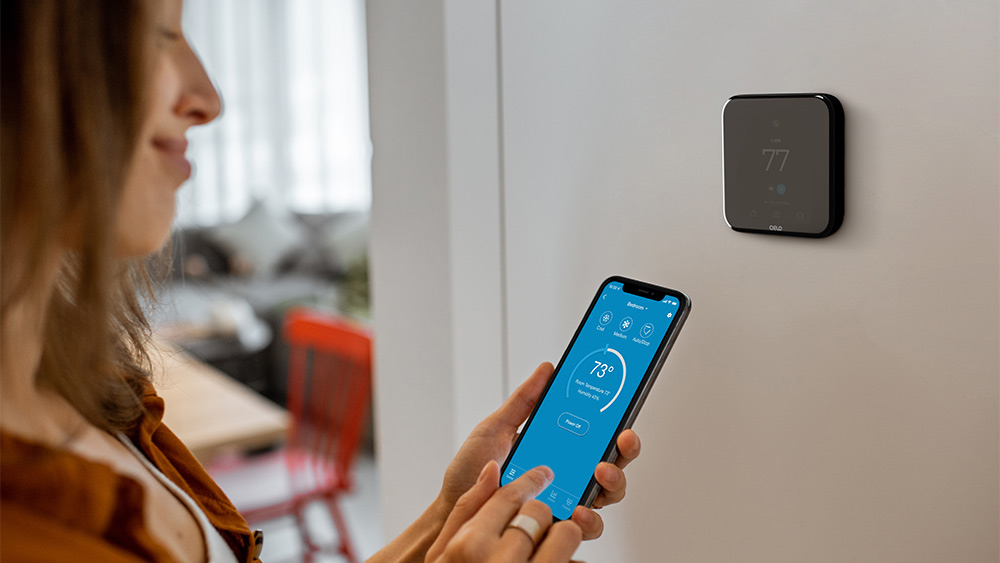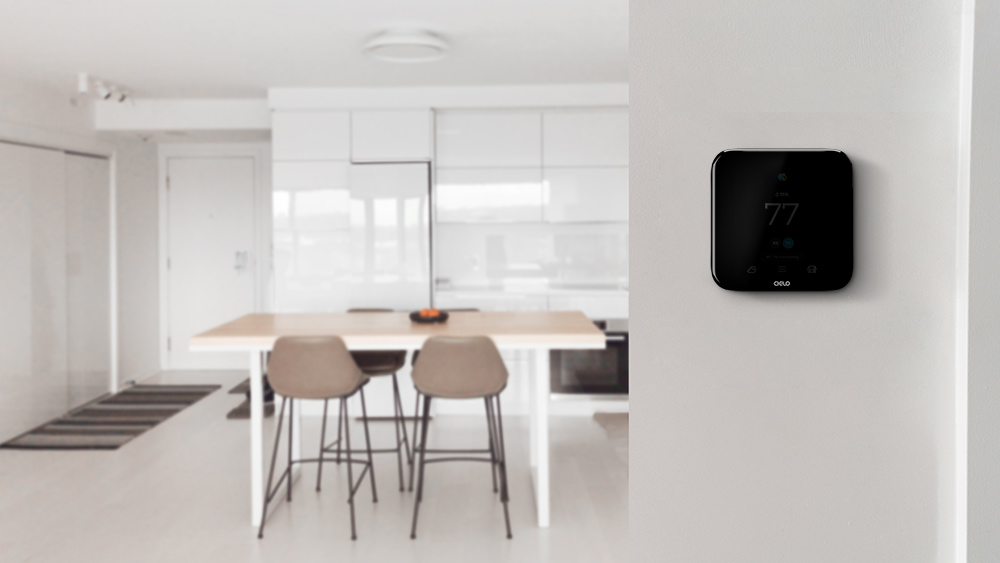
Key Takeaways
- Smart thermostats connect your unit to the internet, allowing you to control your home climate using your phone.
- With smart thermostats, you can automate your heating/cooling based on your routine using schedules.
- They can also track energy usage, provide maintenance reminders, and integrate with various smart home devices.
Imagine entering your home after an exhausting grocery run and being greeted by a perfectly chilled or heated home. Or leaving your home in a hurry and having your air conditioning automatically turn off.
No kidding, you can achieve this level of comfort with the help of smart thermostats. They automate your home climate —all while saving energy and giving you remote access from your phone. With this smart home gadget, you can easily set a daily/weekly schedule or check up on your home temperature when you are on vacation. Plus, you can monitor and maintain ideal humidity levels and even track your energy usage. All in all, a smart thermostat is a perfect device for a comfortable home environment.
If you’re thinking about upgrading to a smart thermostat, you might be interested in how smart thermostats work. This blog will touch on the basic working of these smart devices and other frequently asked thermostat questions to help you make the smart choice and enjoy a perfect temperature all year round.
- How Do Smart Thermostats Work?
- Can Smart Thermostats Work Without a Wi-Fi Connection?
- Will a Smart Thermostat Work With Your Home's Wiring System?
- How Do Smart Thermostat Room Sensors Work?
- What Are the Main Features of a Smart Thermostat?
- How to Set Your Smart Thermostat?
- Are All Phone Operating Systems Compatible With Smart Thermostats?
- What Is the Best Thermostat Location in Your House?
- How to Install a Smart Thermostat?
- How Much Does a Smart Thermostat Cost?
- What Are the Advantages of a Smart Thermostat?
- In Conclusion
How Do Smart Thermostats Work?
Smart thermostats connect your HVAC system to the internet, allowing you to control your home temperature remotely using your phone.
Smart thermostats work by sensing your home’s ambient temperature and then sending a signal to your heating and cooling system to make the changes according to your pre-set schedule. If it senses the temperature rising above the set limit, it will send a signal to the receiver to lower the temperature. Too cold? It will turn it back up to maintain your desired settings.
You can also change your thermostat settings using your phone. You can set your preferred temperature and humidity level, define your schedule, view usage history, and a lot more. When you input a setting using a mobile app, that input is transmitted over your Wi-Fi network to the thermostat, which then sends the signal over to your HVAC system.
Advanced smart home thermostat models also have learning capabilities. They learn what temperature you like at different times of the day based on when you are home or away and then devise a heating and cooling schedule tailored to your requirements.
These smart climate control devices have a powerful processor to handle all the input commands and a memory board to store the information. They also have an antenna to communicate wirelessly. In addition to a wired connection, many models also have a lithium-ion battery to keep your thermostat running in case of a power outage.
Can Smart Thermostats Work Without a Wi-Fi Connection?
A smart thermostat does not require an internet connection to monitor and maintain your home temperature. However, your access to other features will be limited without a Wi-Fi connection. For instance, you won’t be able to remotely control your AC from your phone or use features such as scheduling and geofencing. You will only be able to adjust the setting using the on-device controls.
Will a Smart Thermostat Work With Your Home’s Wiring System?
Like other types of thermostats, a smart thermostat has to be connected to your home’s wiring system to have a continuous supply of power. To check whether your wiring system is compatible with your smart thermostat, turn off your current thermostat and remove its front panel. Check its backside where the wiring is connected. Check for wire labeled C-wire. If you spot a C-wire, a smart thermostat can work in your home.
However, if you don’t have a C-wire, you can call a technician and have it installed. Some thermostats also come with a C-wire adapter in the box.
Related: Thermostat Wiring Explained in Detail!
How Do Smart Thermostat Room Sensors Work?
A smart thermostat can only sense the temperature of the room it’s installed in. Different rooms in your home have different temperature requirements. So, cooling/heating your home based on one temperature reading can impact your comfort levels.
This is where sensors come into play. Smart thermostat sensors are installed throughout the house and work by detecting temperature in different rooms and passing that information to the main thermostat. Your thermostat will then use the average reading to keep a comfortable environment.
What Are the Main Features of a Smart Thermostat?

Smart thermostats provide greater control over your home climate and help save on energy, using features such as scheduling, tracking usage, and more.
Scheduling
With smart home thermostats, you can set daily or weekly schedules depending on your routine and weather forecasts. For instance, you can set a lower daytime temperature in summer and turn it up at night when it gets a bit cooler.
Geofencing
The geofencing mode on a smart thermostat can turn on/off your AC when you enter or leave your set location. This feature will turn your AC off when you move a certain distance away from your set parameters and turn it on when you are near your location. This way, you never come back to a burning home on a hot day, and your HVAC unit isn’t running when you’re away.
Equip your HVAC system with smart features and achieve the perfect balance between comfort & savings.
Learn more
Tracking Energy Usage
A smart thermostat monitors your energy use and compiles the information in a report that you can access from your mobile app. This enables you to make necessary changes and save money. Some smart thermostat models also list the reasons why your energy usage may have increased or decreased during a specific period.
Safety Temperatures
This feature can help protect your home during extreme temperatures. In summer, if your home temperature goes above the defined limit, the cool mode will automatically make adjustments to prevent overheating. This mode will protect your pipes from freezing over in winter by running in heat mode while consuming minimum power.
Smart Home Integration
Most smart thermostat models support voice-controlled personal assistants like Amazon Alexa and Google Assistant, giving you the flexibility of hands-off control. IFTTT is also supported by many thermostats, which allows you to connect your smart thermostat to other smart home devices.
Maintenance Reminders
A smart thermostat monitors your AC filter usage and sends reminders on your phone when the cleaning is due.
How to Set Your Smart Thermostat?
After installing your smart thermostat, you can set your preferred settings using on-screen control. Tap on the screen and choose cool or heat mode. Then use arrow keys to adjust the temperature. You can also use your phone app to make adjustments.
Are All Phone Operating Systems Compatible With Smart Thermostats?

Typically, most Android and Apple operating systems (OS) work well with smart thermostats. However, if your phone has a different OS, you will have to contact your thermostat’s manufacturer to check the compatibility.
What Is the Best Thermostat Location in Your House?
The ideal thermostat placement is in the center of your home, in a room that you frequently use, away from direct sunlight. You should avoid placing it near doors and windows to prevent drafts from affecting the readings.
Incorrect placement can impact the performance of your thermostat. Here is a troubleshooting guide in case your thermostat stops working.
How to Install a Smart Thermostat?
Installing a smart thermostat may sound tricky; however, you can easily DIY the process following the manual instructions.
- Turn off your circuit breaker.
- Remove the faceplate on your old thermostat.
- Use your phone to take pictures of the wiring system inside the old thermostat. Check if the wires are correctly linked with their labels. For example, a green-colored wire will have a G label.
- Then unscrew the backplate and install your new thermostat plate.
- After that, start attaching the wires to their corresponding labels. If your wires don’t have tags, take out your phone and look at the photos you took earlier to match the color of each wire to its correct tab.
- Attach the smart thermostat faceplate.
- Turn on the thermostat and follow the instructions on the screen. After the setup, you can enjoy automated climate control in no time!
How Much Does a Smart Thermostat Cost?

Smart thermostats cost between $75 and $300 but can pay for themselves over time by helping to lower your energy bills.
When it comes to smart thermostat installation costs, most homeowners pay between $200 to $500 to install it. The devices with basic features and an existing C-wire are priced at around $170. The installation of a smart thermostat with auto start function and two-year warranty along with C-wire installation costs $ 300.
What Are the Advantages of a Smart Thermostat?
Here are the top 3 benefits of installing a smart thermostat in your home.
Save Money on Energy Bills
Smart thermostats send you monthly energy reports to help you better understand your energy usage. With continuous smart thermostat use, the report will also compare your usage to previous months and what factors influenced the changes. Another way smart thermostats save energy is by sensing when you are home and when you are away and then automatically changing the mode.
Check out this thermostat energy-saving guide to lower your bills.
Remote AC Control
The ability to control your air conditioner remotely can significantly increase your comfort. For instance, if you are coming home earlier than your scheduled time, you can simply use your phone to turn on your AC on your way and arrive at a perfectly chilled home.
Learning Capability
Advanced models have in-built learning functions that learn when you are home and when your air conditioning needs to be turned on. Then, they use this data to automatically create a heating and cooling schedule for you.
In Conclusion
Smart thermostats regulate your home temperature and allow you to control your AC settings using your phone. They work by optimizing your home climate based on your preference, location, and schedule. Not only do they make your home more comfortable, but they also help you save money in the long run. If you’re looking for a way to make your home more efficient, a smart thermostat is definitely worth considering.








